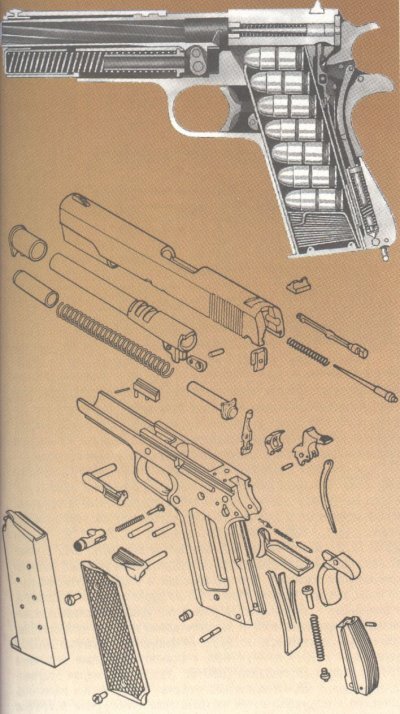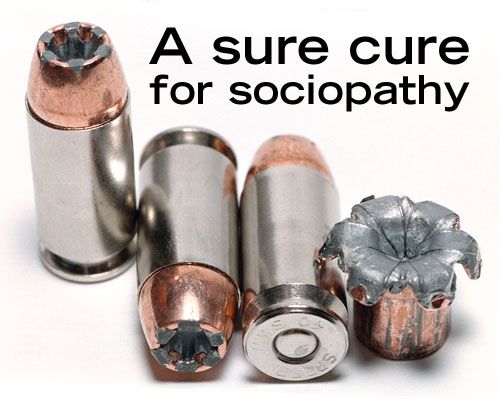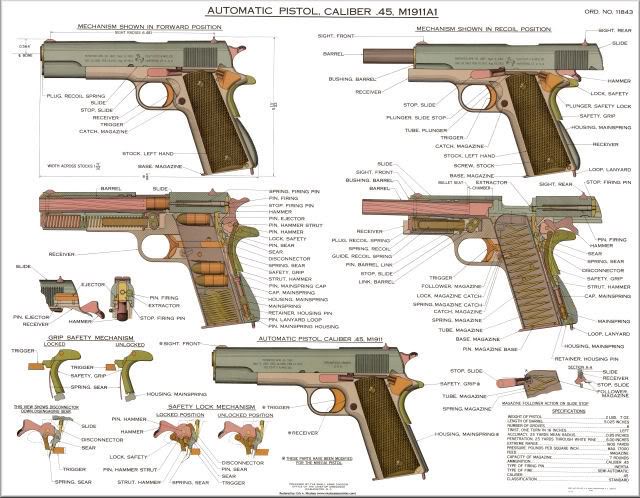The Colt pistol was formally adopted by the Army on March 29, 1911, thus gaining its designation, M1911 (Model of 1911). It was adopted by the Navy and Marine Corps in 1913. Originally manufactured only by Colt, demand for the firearm in World War I saw the expansion of manufacture to the government-owned Springfield Armory.
Battlefield experience in the First World War led to some more small external changes, completed in 1924. The new version received a modified type classification, M1911A1. Changes to the original design were minor and consisted of a shorter trigger, cutouts in the frame behind the trigger, an arched mainspring housing, a longer grip safety spur (to prevent hammer bite), a wider front sight, a shorter spur on the hammer, and simplified grip checkering by eliminating the "Double Diamond" reliefs.
Those unfamiliar with the design are often unable to tell the difference between the two versions at a glance. No significant internal changes were made, and parts remained interchangeable between the two.
 The
history of the Colt Gov't / M1911 Pistol began in early 1900s, when
famous designer John M. Browning began to develop semi-automatic
pistols for Colt company. In the 1906-1907 U.S. Army announced
trials to replace its service revolvers with new, semi-automatic
pistol. Army required the new pistol to have the caliber of .45
inch, so Browning designed its own cartridge that fired 230 grains
(15.64 gram) bullet, and then, designed a new pistol. In 1911,
after extensive testing's, the new pistol and its cartridge,
designed by Browning and manufactured by Colt, were adopted for U.S.
military service as M1911. Prior to and during World War One, more
than one million of these guns were manufactured, mostly by Colt and
Springfield Armory, as well as by Remington-UMC, Burroughs, Savage
and some other companies. The rights to manufacture Colt/Browning
design were also sold to some foreign countries, such as Norway or
Argentine.
The
history of the Colt Gov't / M1911 Pistol began in early 1900s, when
famous designer John M. Browning began to develop semi-automatic
pistols for Colt company. In the 1906-1907 U.S. Army announced
trials to replace its service revolvers with new, semi-automatic
pistol. Army required the new pistol to have the caliber of .45
inch, so Browning designed its own cartridge that fired 230 grains
(15.64 gram) bullet, and then, designed a new pistol. In 1911,
after extensive testing's, the new pistol and its cartridge,
designed by Browning and manufactured by Colt, were adopted for U.S.
military service as M1911. Prior to and during World War One, more
than one million of these guns were manufactured, mostly by Colt and
Springfield Armory, as well as by Remington-UMC, Burroughs, Savage
and some other companies. The rights to manufacture Colt/Browning
design were also sold to some foreign countries, such as Norway or
Argentine.  This
is a 1912 manufactured Colt that has retained all of the
characteristics of the original design by Colt over the years and
the first gun of the 2nd batch made Colt.. This is a VERY early Colt
production .45 calibre that was presented to Army Major William G.
Penfield who played a major role in the development of the standards for
the Colt contract. Below:
Original presentation case. (1585)
This
is a 1912 manufactured Colt that has retained all of the
characteristics of the original design by Colt over the years and
the first gun of the 2nd batch made Colt.. This is a VERY early Colt
production .45 calibre that was presented to Army Major William G.
Penfield who played a major role in the development of the standards for
the Colt contract. Below:
Original presentation case. (1585) allowing the gun to be carried in "cocked and locked" state, with safety
on, hammer cocked and round chambered. Additional automated safety
incorporated into rear of the grip and locks the action when gun not
held in the hand properly. On the earliest examples, the serial
number was located on the forward right side of the frame.
allowing the gun to be carried in "cocked and locked" state, with safety
on, hammer cocked and round chambered. Additional automated safety
incorporated into rear of the grip and locks the action when gun not
held in the hand properly. On the earliest examples, the serial
number was located on the forward right side of the frame.

